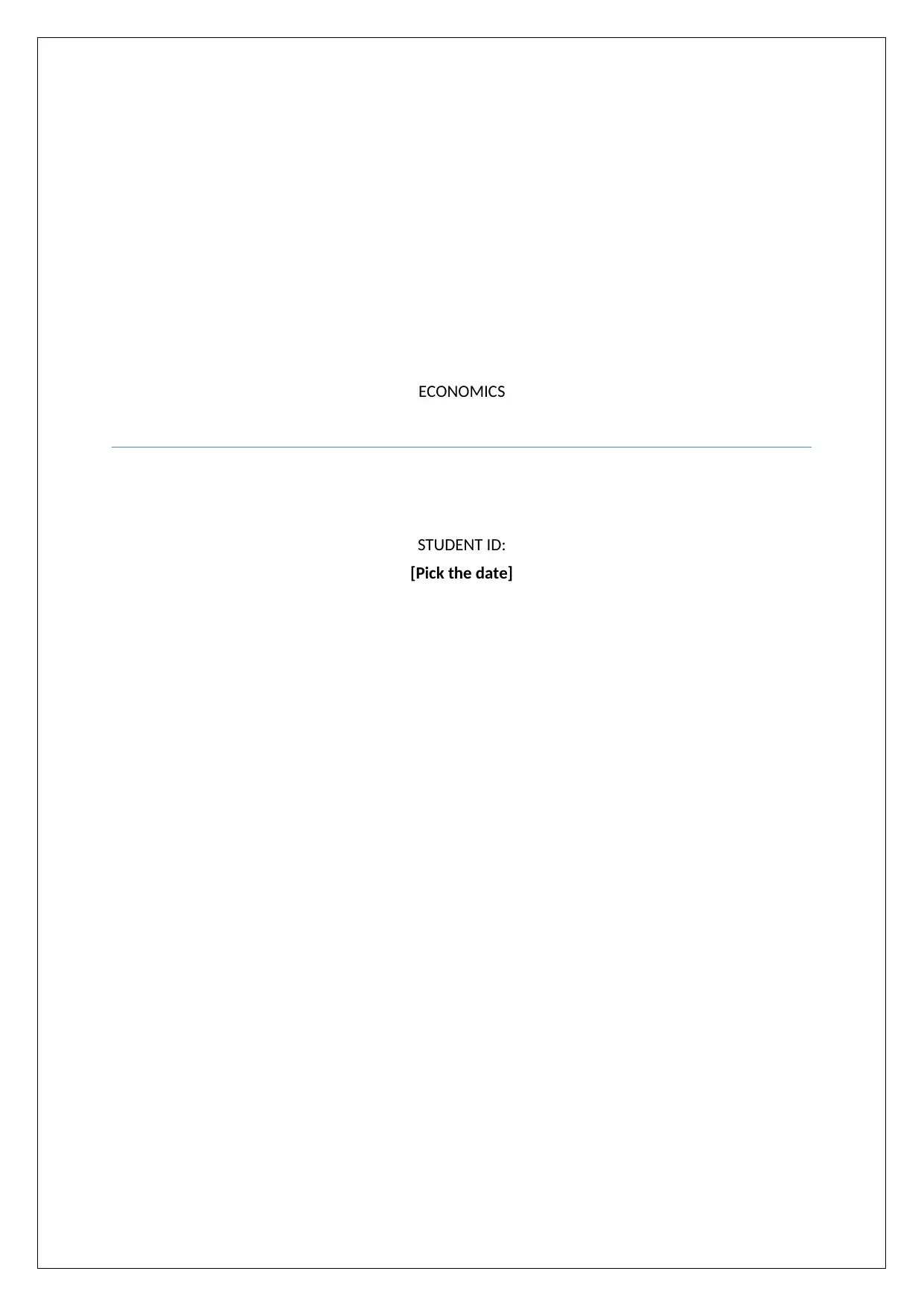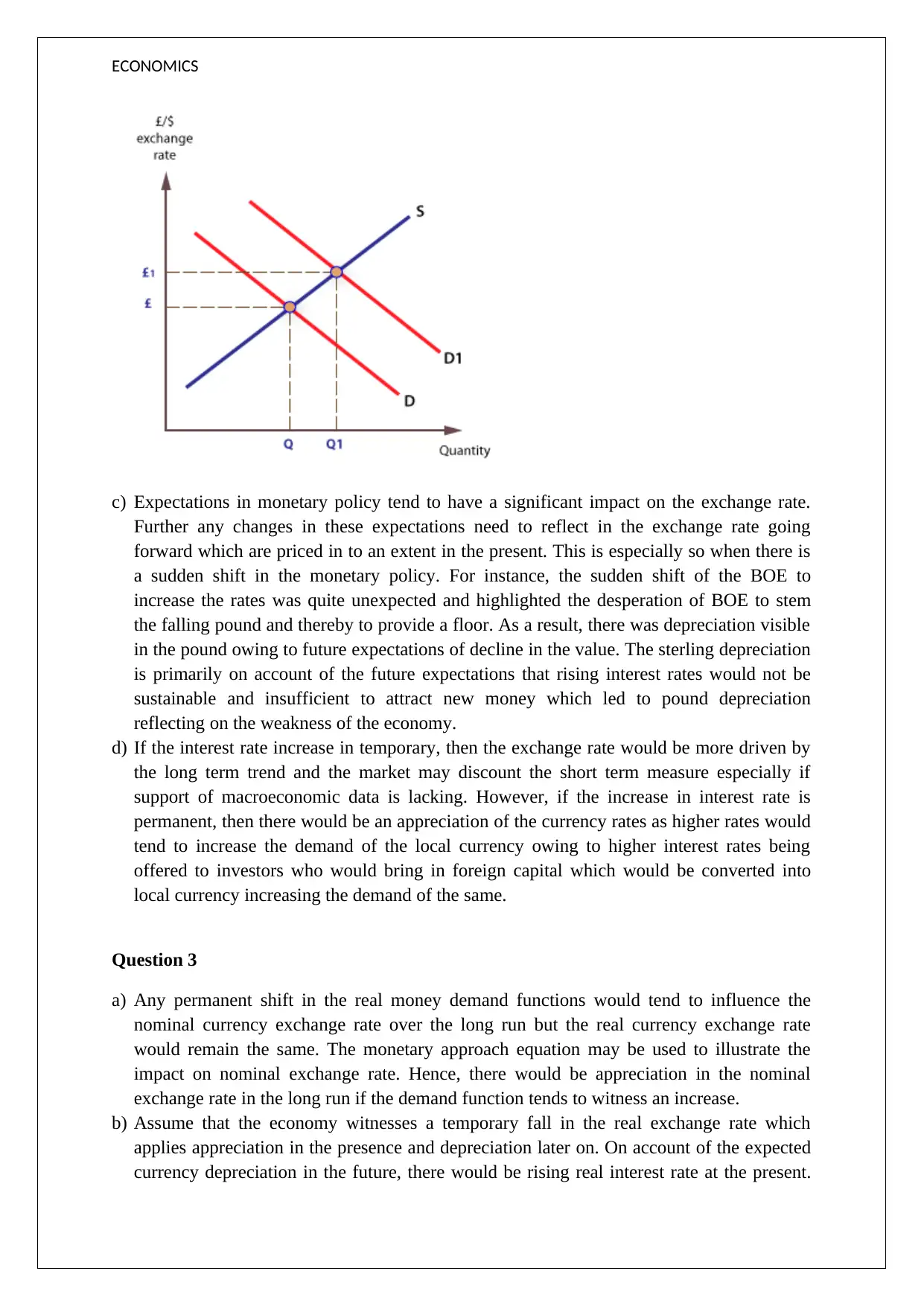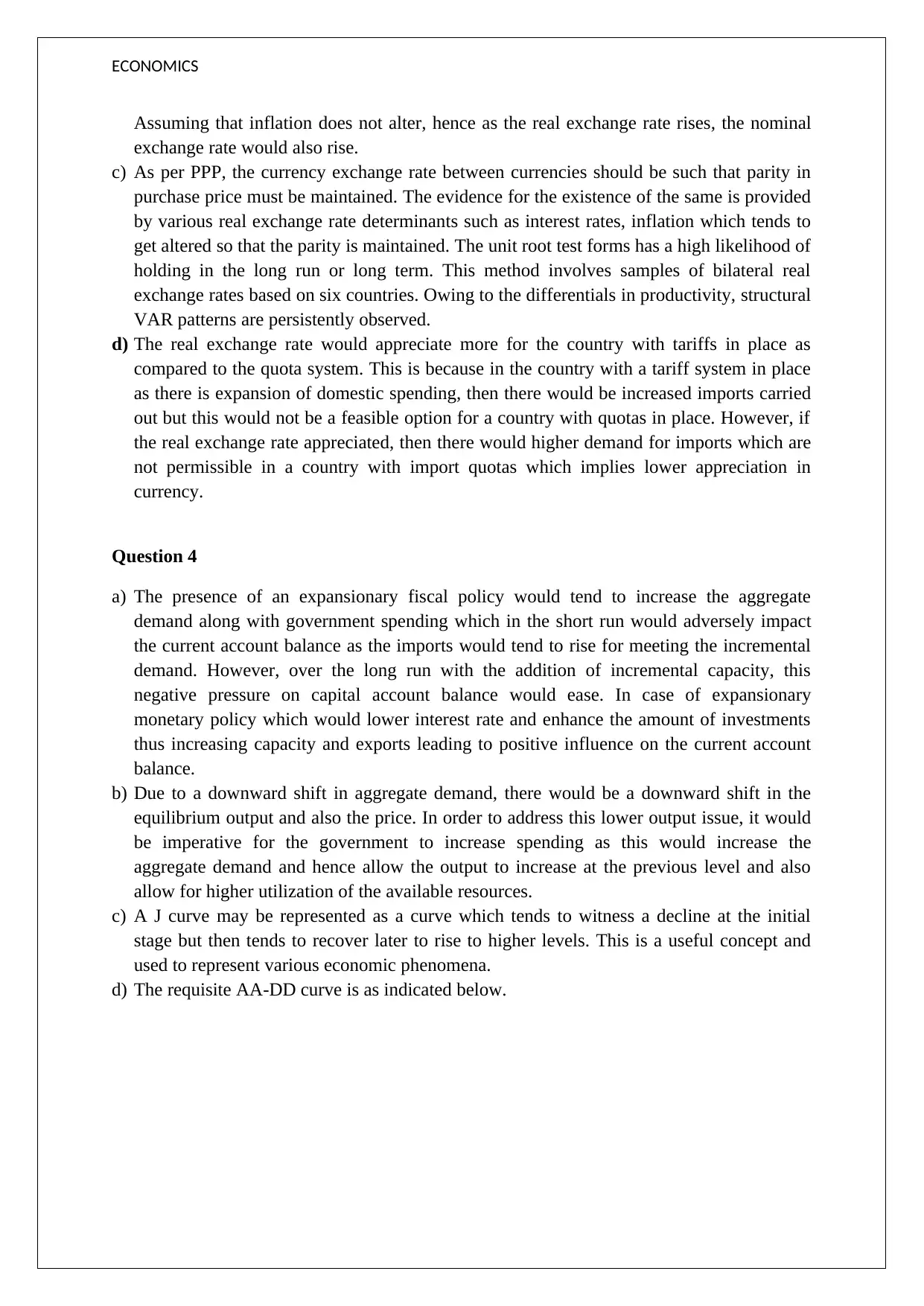Economics: Monetary & Fiscal Policy Impact on Exchange Rates
VerifiedAdded on 2023/06/15
|6
|1978
|259
Homework Assignment
AI Summary
This economics assignment delves into various aspects of exchange rates, monetary policy, and their interplay. It examines the relationship between risk and euro-dominated assets, the stability of currencies like the pound versus emerging market currencies, and the impact of liquidity on currency...

ECONOMICS
STUDENT ID:
[Pick the date]
STUDENT ID:
[Pick the date]
Paraphrase This Document
Need a fresh take? Get an instant paraphrase of this document with our AI Paraphraser

ECONOMICS
Question 1
a) Higher risk would be associated with euro dominated assets. When the wealth is
unexpectedly higher, the euro tends to appreciate and hence a positive relationship is
shared. Hence, this implies that when the wealth yields a lower return, then the euro would
witness depreciation against the pound. This would further lower the payoff and it would
be better to have yen dominated assets which would appreciate and hence provide some
cushion.
b) It is imperative to note that unlike an emerging market currency such as Algerian Dinar,
there would be high stability in the pound. This would reflect in the deposits which would
have a higher liquidity in comparison with the Algerian Dinar which would have lower
liquidity. As a result, it would be expected that the interest rates on the UK pound deposits
would be lower in comparison to Algerian Dinar since people emerging currency deposits
are more volatile and incentive as higher rates need to be provided.
c) If the liquidity characteristics of the Algerian dinar would improve, then there would be a
decrease in the liquidity risk associated with the holding of Algerian currency and hence
the demand would increase which would ensure that there is an appreciation of the dinar
against the pound assuming everything else remains constant.
d) This phenomenon is known as Yen carry trade and has been exceptionally popular with
hedge funds in the past that used to borrow at lower interest rates and invest the money in
countries where the interest rates would be higher and thereby making a hefty profit.
Assume that the interest rate on Japanese Yen is 0.5% pa. Consider that the interest rate on
currency in Australia is 4% p.a. Hence, the money borrowed in Japanese Yen can be
converted in AUD and invested so as to increase the returns by earning a hefty profit.
Ofcourse there is currency exchange risk associated with this strategy.
This strategy works only when interest rate parity is not reflected in the currency rates.
Question 2
a) The interest rate is dependent upon the money demand and money supply. If the money
supply tends to increase while the money demand remains constant, then there would be a
decrease in the interest rates owing to higher liquidity. On the other hand, if there is a
decrease in the money supply, then there would be an increase in interest rates on account
of lower liquidity assuming money demand is constant.
b) Due to increase in the interest rate in UK, there would be higher money inflow in the form
of deposits in pound and hence the demand of pound would increase to some extent which
would help to some extent to address the current depreciation that is being witnessed. As a
result, it has been considered as an equivalent of providing a floor or slowing down the
depreciation. This can be graphically illustrated as shown below.
Question 1
a) Higher risk would be associated with euro dominated assets. When the wealth is
unexpectedly higher, the euro tends to appreciate and hence a positive relationship is
shared. Hence, this implies that when the wealth yields a lower return, then the euro would
witness depreciation against the pound. This would further lower the payoff and it would
be better to have yen dominated assets which would appreciate and hence provide some
cushion.
b) It is imperative to note that unlike an emerging market currency such as Algerian Dinar,
there would be high stability in the pound. This would reflect in the deposits which would
have a higher liquidity in comparison with the Algerian Dinar which would have lower
liquidity. As a result, it would be expected that the interest rates on the UK pound deposits
would be lower in comparison to Algerian Dinar since people emerging currency deposits
are more volatile and incentive as higher rates need to be provided.
c) If the liquidity characteristics of the Algerian dinar would improve, then there would be a
decrease in the liquidity risk associated with the holding of Algerian currency and hence
the demand would increase which would ensure that there is an appreciation of the dinar
against the pound assuming everything else remains constant.
d) This phenomenon is known as Yen carry trade and has been exceptionally popular with
hedge funds in the past that used to borrow at lower interest rates and invest the money in
countries where the interest rates would be higher and thereby making a hefty profit.
Assume that the interest rate on Japanese Yen is 0.5% pa. Consider that the interest rate on
currency in Australia is 4% p.a. Hence, the money borrowed in Japanese Yen can be
converted in AUD and invested so as to increase the returns by earning a hefty profit.
Ofcourse there is currency exchange risk associated with this strategy.
This strategy works only when interest rate parity is not reflected in the currency rates.
Question 2
a) The interest rate is dependent upon the money demand and money supply. If the money
supply tends to increase while the money demand remains constant, then there would be a
decrease in the interest rates owing to higher liquidity. On the other hand, if there is a
decrease in the money supply, then there would be an increase in interest rates on account
of lower liquidity assuming money demand is constant.
b) Due to increase in the interest rate in UK, there would be higher money inflow in the form
of deposits in pound and hence the demand of pound would increase to some extent which
would help to some extent to address the current depreciation that is being witnessed. As a
result, it has been considered as an equivalent of providing a floor or slowing down the
depreciation. This can be graphically illustrated as shown below.

ECONOMICS
c) Expectations in monetary policy tend to have a significant impact on the exchange rate.
Further any changes in these expectations need to reflect in the exchange rate going
forward which are priced in to an extent in the present. This is especially so when there is
a sudden shift in the monetary policy. For instance, the sudden shift of the BOE to
increase the rates was quite unexpected and highlighted the desperation of BOE to stem
the falling pound and thereby to provide a floor. As a result, there was depreciation visible
in the pound owing to future expectations of decline in the value. The sterling depreciation
is primarily on account of the future expectations that rising interest rates would not be
sustainable and insufficient to attract new money which led to pound depreciation
reflecting on the weakness of the economy.
d) If the interest rate increase in temporary, then the exchange rate would be more driven by
the long term trend and the market may discount the short term measure especially if
support of macroeconomic data is lacking. However, if the increase in interest rate is
permanent, then there would be an appreciation of the currency rates as higher rates would
tend to increase the demand of the local currency owing to higher interest rates being
offered to investors who would bring in foreign capital which would be converted into
local currency increasing the demand of the same.
Question 3
a) Any permanent shift in the real money demand functions would tend to influence the
nominal currency exchange rate over the long run but the real currency exchange rate
would remain the same. The monetary approach equation may be used to illustrate the
impact on nominal exchange rate. Hence, there would be appreciation in the nominal
exchange rate in the long run if the demand function tends to witness an increase.
b) Assume that the economy witnesses a temporary fall in the real exchange rate which
applies appreciation in the presence and depreciation later on. On account of the expected
currency depreciation in the future, there would be rising real interest rate at the present.
c) Expectations in monetary policy tend to have a significant impact on the exchange rate.
Further any changes in these expectations need to reflect in the exchange rate going
forward which are priced in to an extent in the present. This is especially so when there is
a sudden shift in the monetary policy. For instance, the sudden shift of the BOE to
increase the rates was quite unexpected and highlighted the desperation of BOE to stem
the falling pound and thereby to provide a floor. As a result, there was depreciation visible
in the pound owing to future expectations of decline in the value. The sterling depreciation
is primarily on account of the future expectations that rising interest rates would not be
sustainable and insufficient to attract new money which led to pound depreciation
reflecting on the weakness of the economy.
d) If the interest rate increase in temporary, then the exchange rate would be more driven by
the long term trend and the market may discount the short term measure especially if
support of macroeconomic data is lacking. However, if the increase in interest rate is
permanent, then there would be an appreciation of the currency rates as higher rates would
tend to increase the demand of the local currency owing to higher interest rates being
offered to investors who would bring in foreign capital which would be converted into
local currency increasing the demand of the same.
Question 3
a) Any permanent shift in the real money demand functions would tend to influence the
nominal currency exchange rate over the long run but the real currency exchange rate
would remain the same. The monetary approach equation may be used to illustrate the
impact on nominal exchange rate. Hence, there would be appreciation in the nominal
exchange rate in the long run if the demand function tends to witness an increase.
b) Assume that the economy witnesses a temporary fall in the real exchange rate which
applies appreciation in the presence and depreciation later on. On account of the expected
currency depreciation in the future, there would be rising real interest rate at the present.
⊘ This is a preview!⊘
Do you want full access?
Subscribe today to unlock all pages.

Trusted by 1+ million students worldwide

ECONOMICS
Assuming that inflation does not alter, hence as the real exchange rate rises, the nominal
exchange rate would also rise.
c) As per PPP, the currency exchange rate between currencies should be such that parity in
purchase price must be maintained. The evidence for the existence of the same is provided
by various real exchange rate determinants such as interest rates, inflation which tends to
get altered so that the parity is maintained. The unit root test forms has a high likelihood of
holding in the long run or long term. This method involves samples of bilateral real
exchange rates based on six countries. Owing to the differentials in productivity, structural
VAR patterns are persistently observed.
d) The real exchange rate would appreciate more for the country with tariffs in place as
compared to the quota system. This is because in the country with a tariff system in place
as there is expansion of domestic spending, then there would be increased imports carried
out but this would not be a feasible option for a country with quotas in place. However, if
the real exchange rate appreciated, then there would higher demand for imports which are
not permissible in a country with import quotas which implies lower appreciation in
currency.
Question 4
a) The presence of an expansionary fiscal policy would tend to increase the aggregate
demand along with government spending which in the short run would adversely impact
the current account balance as the imports would tend to rise for meeting the incremental
demand. However, over the long run with the addition of incremental capacity, this
negative pressure on capital account balance would ease. In case of expansionary
monetary policy which would lower interest rate and enhance the amount of investments
thus increasing capacity and exports leading to positive influence on the current account
balance.
b) Due to a downward shift in aggregate demand, there would be a downward shift in the
equilibrium output and also the price. In order to address this lower output issue, it would
be imperative for the government to increase spending as this would increase the
aggregate demand and hence allow the output to increase at the previous level and also
allow for higher utilization of the available resources.
c) A J curve may be represented as a curve which tends to witness a decline at the initial
stage but then tends to recover later to rise to higher levels. This is a useful concept and
used to represent various economic phenomena.
d) The requisite AA-DD curve is as indicated below.
Assuming that inflation does not alter, hence as the real exchange rate rises, the nominal
exchange rate would also rise.
c) As per PPP, the currency exchange rate between currencies should be such that parity in
purchase price must be maintained. The evidence for the existence of the same is provided
by various real exchange rate determinants such as interest rates, inflation which tends to
get altered so that the parity is maintained. The unit root test forms has a high likelihood of
holding in the long run or long term. This method involves samples of bilateral real
exchange rates based on six countries. Owing to the differentials in productivity, structural
VAR patterns are persistently observed.
d) The real exchange rate would appreciate more for the country with tariffs in place as
compared to the quota system. This is because in the country with a tariff system in place
as there is expansion of domestic spending, then there would be increased imports carried
out but this would not be a feasible option for a country with quotas in place. However, if
the real exchange rate appreciated, then there would higher demand for imports which are
not permissible in a country with import quotas which implies lower appreciation in
currency.
Question 4
a) The presence of an expansionary fiscal policy would tend to increase the aggregate
demand along with government spending which in the short run would adversely impact
the current account balance as the imports would tend to rise for meeting the incremental
demand. However, over the long run with the addition of incremental capacity, this
negative pressure on capital account balance would ease. In case of expansionary
monetary policy which would lower interest rate and enhance the amount of investments
thus increasing capacity and exports leading to positive influence on the current account
balance.
b) Due to a downward shift in aggregate demand, there would be a downward shift in the
equilibrium output and also the price. In order to address this lower output issue, it would
be imperative for the government to increase spending as this would increase the
aggregate demand and hence allow the output to increase at the previous level and also
allow for higher utilization of the available resources.
c) A J curve may be represented as a curve which tends to witness a decline at the initial
stage but then tends to recover later to rise to higher levels. This is a useful concept and
used to represent various economic phenomena.
d) The requisite AA-DD curve is as indicated below.
Paraphrase This Document
Need a fresh take? Get an instant paraphrase of this document with our AI Paraphraser

ECONOMICS
While in the above diagram, the slope of both AA and DD curves is downwards only but it is
noteworthy that AA curves are less steep than the corresponding DD curves. The temporary
monetary expansion would lead to a shift in the asset market curve as denoted from AA to
AA1.This leads to equilibrium point changing from 1 to 3 and resulting in currency
depreciation and lower output in short run. However, temporary fiscal expansion would lead
to an output shift from DD to DD1. Hence, the equilibrium would shift to point 2 from
initially 1 resulting in current appreciation and also a higher output in short run. With regards
to permanent changes in policies, there is fading of J effect in the long term as the effect
becomes more permanent.
Question 5
a) In order to maintain a fixed currency, the central bank needs to buy and sell foreign
currency so that the exchange rate is maintained at the rate desired. For instance, if there is
appreciation pressure on the local currency, the foreign currency would be bought thereby
increasing the demand of the same and bringing down the local currency.
b) When the exchange rate is floating, then the monetary authority has high degree of
autonomy as the policy is not driven by exchange rate considerations only and usually
inflation is the driving force. This is in sharp contrast with a fixed exchange rate regime
where monetary policy is driven by the exchange rate considerations. The fiscal policy
under a fixed exchange rate is also constrained as any major expansion or contraction in
the economy would have impact on the currency exchange rate which would require the
intervention of the monetary authority. Hence, the changes are constrained by the ability
of the monetary authority to balance the effect of the fiscal policy on the exchange rate. In
contrast, floating exchange rate provides a greater flexibility and freedom to policymakers
who are more driven by economic considerations and objectives.
c) A self –fulfilling crisis is one which is not the direct consequence of fundamental issues
with the economy or faulty government policy but rather result from the expectations and
behaviour of the market participants. This is especially true for currency. For instance,
assuming that the foreign reserves are low and the government is trying to cut down.
However, owing to low reserves, there would be selling pressure on the domestic currency
while at the same time buying of foreign currency which would cause an appreciation of
While in the above diagram, the slope of both AA and DD curves is downwards only but it is
noteworthy that AA curves are less steep than the corresponding DD curves. The temporary
monetary expansion would lead to a shift in the asset market curve as denoted from AA to
AA1.This leads to equilibrium point changing from 1 to 3 and resulting in currency
depreciation and lower output in short run. However, temporary fiscal expansion would lead
to an output shift from DD to DD1. Hence, the equilibrium would shift to point 2 from
initially 1 resulting in current appreciation and also a higher output in short run. With regards
to permanent changes in policies, there is fading of J effect in the long term as the effect
becomes more permanent.
Question 5
a) In order to maintain a fixed currency, the central bank needs to buy and sell foreign
currency so that the exchange rate is maintained at the rate desired. For instance, if there is
appreciation pressure on the local currency, the foreign currency would be bought thereby
increasing the demand of the same and bringing down the local currency.
b) When the exchange rate is floating, then the monetary authority has high degree of
autonomy as the policy is not driven by exchange rate considerations only and usually
inflation is the driving force. This is in sharp contrast with a fixed exchange rate regime
where monetary policy is driven by the exchange rate considerations. The fiscal policy
under a fixed exchange rate is also constrained as any major expansion or contraction in
the economy would have impact on the currency exchange rate which would require the
intervention of the monetary authority. Hence, the changes are constrained by the ability
of the monetary authority to balance the effect of the fiscal policy on the exchange rate. In
contrast, floating exchange rate provides a greater flexibility and freedom to policymakers
who are more driven by economic considerations and objectives.
c) A self –fulfilling crisis is one which is not the direct consequence of fundamental issues
with the economy or faulty government policy but rather result from the expectations and
behaviour of the market participants. This is especially true for currency. For instance,
assuming that the foreign reserves are low and the government is trying to cut down.
However, owing to low reserves, there would be selling pressure on the domestic currency
while at the same time buying of foreign currency which would cause an appreciation of

ECONOMICS
the foreign currency and thus make it more difficult for the government to buy foreign
exchange to meet the import commitments in the short term thus leading to potential
default and a financial crisis.
d) I agree with this view point as in the absence of capital control, it would be difficult for the
monetary bank to effectively match the various capital flows into the nation. In the long
run, it is possible to maintain a fixed currency exchange rate, when the monetary authority
has capital controls which are often determined based on the ability of the monetary
authority to intervene and sterilise the fund flows. For instance, lack of any capital
controls in the long run may lead to huge inflows progressively for which the monetary
authority or central bank may not be able to provide foreign currency supply.
the foreign currency and thus make it more difficult for the government to buy foreign
exchange to meet the import commitments in the short term thus leading to potential
default and a financial crisis.
d) I agree with this view point as in the absence of capital control, it would be difficult for the
monetary bank to effectively match the various capital flows into the nation. In the long
run, it is possible to maintain a fixed currency exchange rate, when the monetary authority
has capital controls which are often determined based on the ability of the monetary
authority to intervene and sterilise the fund flows. For instance, lack of any capital
controls in the long run may lead to huge inflows progressively for which the monetary
authority or central bank may not be able to provide foreign currency supply.
⊘ This is a preview!⊘
Do you want full access?
Subscribe today to unlock all pages.

Trusted by 1+ million students worldwide
1 out of 6
Related Documents
Your All-in-One AI-Powered Toolkit for Academic Success.
+13062052269
info@desklib.com
Available 24*7 on WhatsApp / Email
![[object Object]](/_next/static/media/star-bottom.7253800d.svg)
Unlock your academic potential
© 2024 | Zucol Services PVT LTD | All rights reserved.





